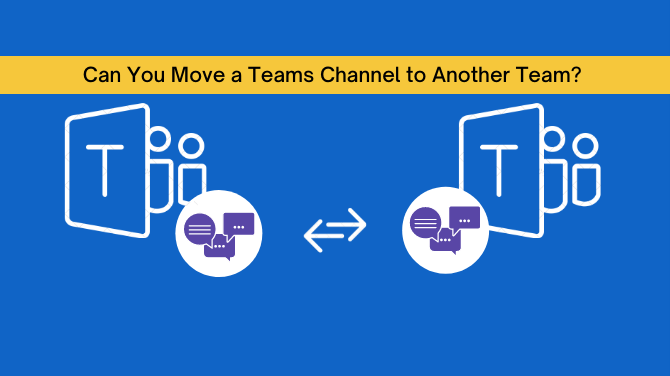Step By Step Guide for Tenant to Tenant Teams Migration


In a step-by-step approach, this article delivers the best insights about Teams tenant to tenant migration. If you want to complete the same task in the near future, you should read this tutorial.
The corporate world has witnessed the rapid adoption of Office 365 in the last couple of years. Also, to stay ahead in the business, organizations frequently deal with merger and acquisition activities which leads them to handle multiple tenants at the same time.
On the other hand, for the convenience of companies, it is better to consolidate multiple tenants within the organization to reduce costs and complexity.
However, we can’t deny the fact, that tenant migration is not an easy task especially tenant to tenant Teams migration. Why? Because Microsoft doesn’t provide any direct method for Teams migration between tenants.
Above all, the storage space distribution of Microsoft Teams makes the task even more challenging. So, what’s the solution then?
Well, don’t worry. Here we will discuss the best suitable method to transfer your data from one MS Teams account to another. So, keep up with the article to find out more information related to Teams migration Project Plan & Checklist.
How Can You Execute a Successful Tenant to Tenant Teams Migration?
First, you need to know what are the three objectives of this migration project. That is,
- Plan,
- Choose the right tool
- And execute a seamless process
Only executing the process is not enough, ensuring the success rate is equally important. And, you can confirm the same with the help of the Microsoft Teams Migration Tool.
This is why, to accomplish the goal of Teams migration, many IT professionals rely on this tried and tested software.
Now, let’s come to the question, what can you migrate using the tool?
Well, you can transfer the entire Teams folder which includes chats, group chats, shared files, channels, Team guest permission, channel analytics, @mentions, Team site, links, emojis, and many more.
Have a Quick Glance at The Distinct Features of The Software
Know more about the trustworthy tool before beginning the process.
- You can quickly and easily move your entire Teams data without any data loss.
- The tool supports multifactor authentication and secures authorization with OAuth 2.0
- It shows a high working performance and also maintains the folder hierarchy on the SharePoint site.
- This software lets you migrate Microsoft Teams and channels in bulk
- At the end of the migration process, you will get a comprehensive report showing the number of channel messages, files, etc are being migrated.
Now, let’s have a look at the ins and outs of the working procedure of the tool.
Conduct Tenants to Tenant Teams Migration Through the Step-by-Step Procedure
The MS Teams migration process may seem impossible to attain but with the right tool, it can become easier.
Hence, thoroughly follow the below steps to execute an error-free tenant to tenant Teams migration.
Step 1. By clicking on the link given, download the above tool. And, launch it on your desktop.
Step 2. After that, go to the ‘Set up’ section. Choose ‘Office 365’ as both Source and Destination for the tenant to tenant Teams migration.
Step 3. Now, scroll down to reach the bottom and mark the ‘Teams’ checkbox. Also, if you like to migrate group data too then you can mark the ‘Groups’ checkbox.
[Note- When you click on the ‘Teams’ field, it will automatically create Teams and public channels at the destination.]
Step 4. Next, turn to the ‘Source’ tab. Type the Admin Email and Application ID correctly. Then, press the ‘Validate’ button and ensure the source permissions turn green.
After that, hit the ‘Next’ button to move forward.
Step 5. Then, go to the ‘Destination’ tab. Type the target ‘Admin Email’ and ‘Application ID’. Click on the ‘Validate’ button and ascertain the desired permissions turn green.
After that, press the ‘Next’ button to move ahead with the tenant to tenant Teams migration.
Step 6. Now, navigate to the ‘Resource’ tab, where you will find three sections i.e. ‘Users’, ‘Teams’, ‘Groups’
First, click on the ‘Users’ section to specify the source user(s). Then, pick an option among these options: ‘Fetch User’, ‘Import User’, ‘Download Template’.
Step 7. After that, all the fetched source emails will reflect on your screen like this.
Step 8. Next, you need to do the mapping of source and destination users.
After that, click on validate and confirm the verification of the necessary permissions turn green.
Step 9. Similar to ‘Users’, fetch teams in the ‘Resource’ tab. And, use any option from ‘fetch teams’, ‘import teams’, ‘download template’ to specify teams.
Step 10. After that, you need to map the source with the destination Team.
To carry out the above, click on the ‘Create Team’ button. Then, type destination names.
Step 11. Next, click on the ‘validate’ button and confirm both source and destination permissions turn green.
Step 12. Click on the Start Migration to execute the tenant to tenant Teams migration.
Step 13. The software facilitates you to perform a ‘Re-run Migration’. Through this, you can retry migrating failed items, re-run full migration, and migrate newly arrived items.
[Note: You need to make sure that you have not clicked on the ‘Mark Teams Complete’ option. Because if you click on the same then you won’t be able to carry out re-run migration.]
Step 14. If you wish to migrate Groups then you can go to the ‘Groups’ section on the ‘Resource’ Tab and follow the directions given below.
First, fetch Groups. Next, provide the Destination Groups emails. After that, Validate permissions.
After a successful verification, you will see the source and destination permission will turn green like the below figure.
Step 15. At last, click on Start Migration to execute Microsoft Teams tenant to tenant migration.
[Note: For any queries related to the tool, refer to the FAQ section discussed at the end]
In a Nut Shell
With the rate at which mergers and acquisitions are taking place, MS Teams migration has become the need of the hour. And, attempting it manually is no less than a nightmare since it involves heavy lifting of data from different locations.
So, instead of wasting a lot of time executing an excessively lengthy and complicated approach, why not opt for a quicker and more efficient automated method!
Using the tried and tested above-mentioned tool is a great idea. It can simplify the migration process for your IT team while bringing in a reduction in downtime.
Frequently Asked Questions
Q. Will I lose the folder structure of my chats and Teams folders?
No, the software maintains the folder structure and timestamp of the chat conversation as it was before migrating.
Q. Is it possible to migrate a private channel using the software?
Yes, you can move a private channel to another tenant but by default, it will migrate it as a public channel. So, you have to manually change it after the completion of the migration.